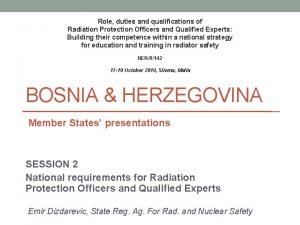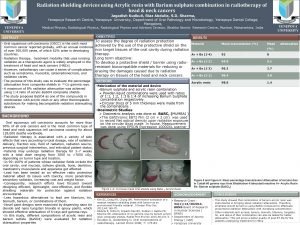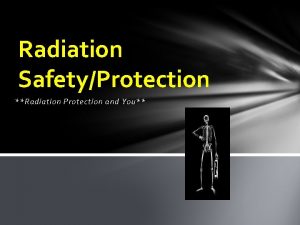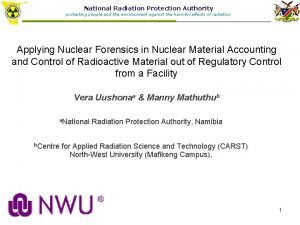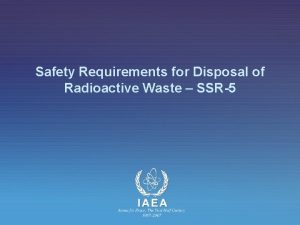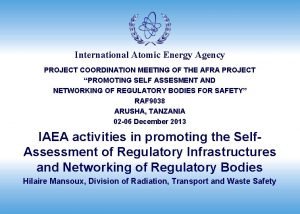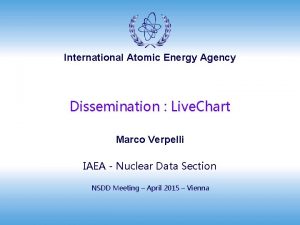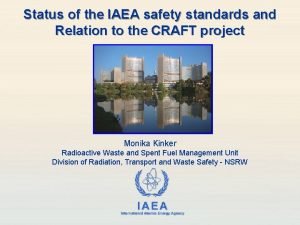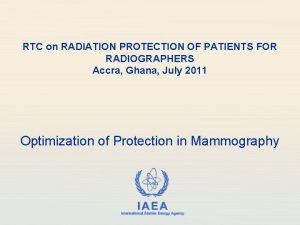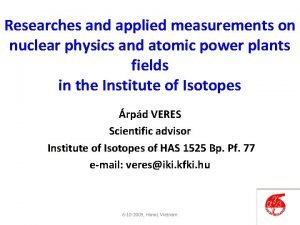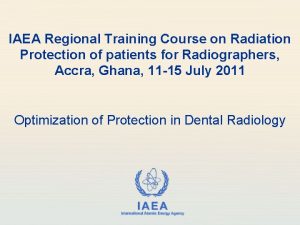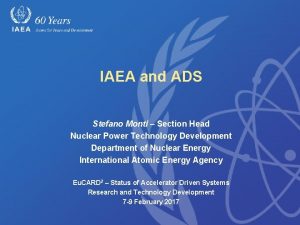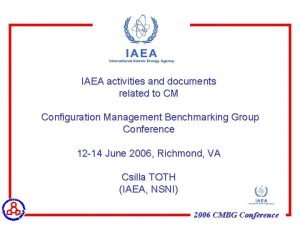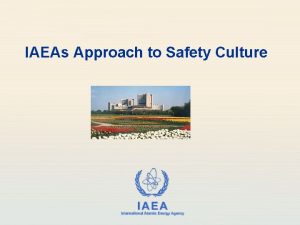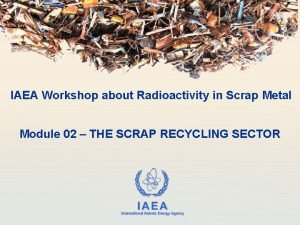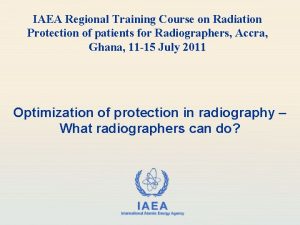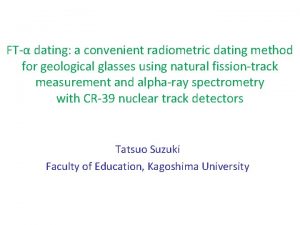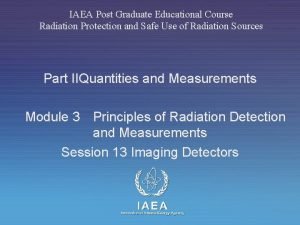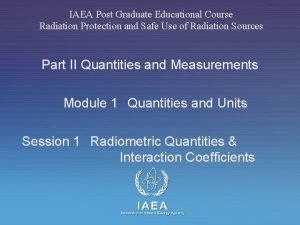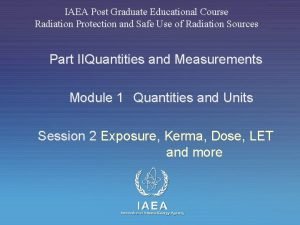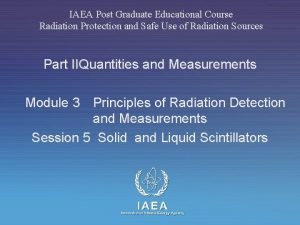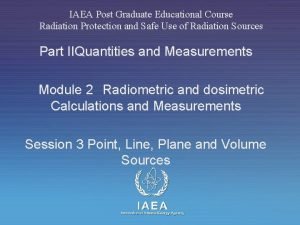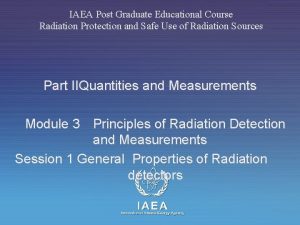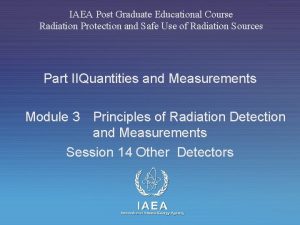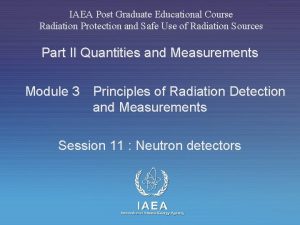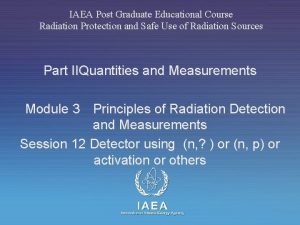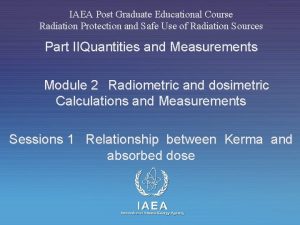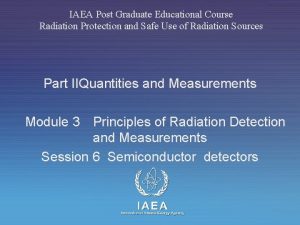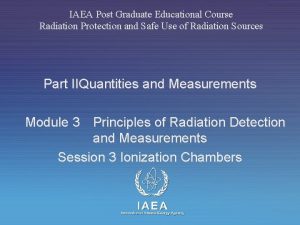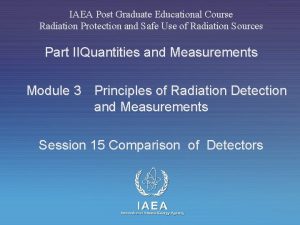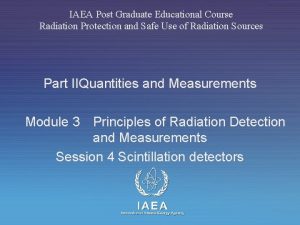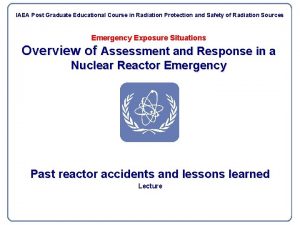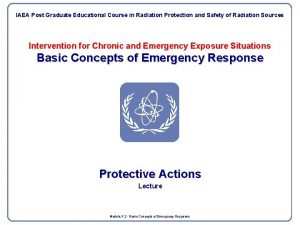IAEA Post Graduate Educational Course Radiation Protection and

















- Slides: 17

IAEA Post Graduate Educational Course Radiation Protection and Safe Use of Radiation Sources Part IIQuantities and Measurements Module 2 Radiometric and dosimetric Calculations and Measurements Session 2 Kerma , Electronic equilibrium and absorbed dose IAEA International Atomic Energy Agency

Overview • Upon completion of this section, the student will be able to: • Understans the relationship between fluence, kerma and absorbed dose • Calculate kerma and absorbed dose IAEA 2

Kerma • KERMA, K, is “Kinetic Energy Released in Matter”. It is energy transferred ( Etr) to charged particles by indirectly ionizing radiation, e. g. , gamma rays and neutrons Etr is just the kinetic energy received by charged particles in a specified volume V, regardless of where or how they spend the energy. The unit of kerma is the Gray (Gy) IAEA 3

Kerma (K) is the expectation value of the energy transferred to charged particles per unit mass at a point of interest, including radiative-loss energy, but excluding energy passed from one charged particle to another. IAEA 4

Kerma (K) and photon fluence The relationship between kerma and photon fluence is given by . ϕ (µ/ρ ) give the number of photon interactions per unit mass of material (µ/ρ ) is the mass attenuation coefficient E tr is the mean energy transferred IAEA 5

Kerma (K) and photon fluence For a spectrum of energies that can be described by dΦ(hv) /d hv, then . hvmax is the maximum energy IAEA 6

Energy Fluence, , is total energy carried by the “rays” striking an infinitesimal sphere of area d. A, during a given time = d. R d. A where R = EN, so = E Units of energy fluence are either Joule-m-2 or erg-cm-2 IAEA 7

KERMA Kerma is equal to the energy fluence times the mass-energy transfer coefficient TR K = ( ) IAEA 8

Relating Kerma and Absorbed dose is energy is transferred in the medium and is the energy retained in the medium brought about by the ionizations along the track of the charged particle . Kerma and Absorbed Dose do not take place at the same location IAEA 9

Relating Kerma and Absorbed dose The figure above shows kerma and absorbed dose do not occur at the same place. Kerma has two components : Collision Kerma ( Kcol ) describe the energy absorbed by medium through inelastic collisions Radiative Kerma ( K rad ) describes the energy lost to bremsstrahlung radiation K = Kcol + Krad IAEA 10

Absorbed dose, D The absorbed dose D is given the relation: d. E ab is the mean energy “imparted” by the ionizing radiation into a mass, dm. Mass should be sufficiently small so that the absorbed dose is defined at a point, but not so small that statistical fluctuations become important. IAEA 11

Worked example 10 Me. V photons are incident on a block of carbon. The photon fluence is 1014 m-2 . What is the kerma ? Answer µ/ρ = 0. 0196 m 2 kg-2 Etr = 7. 3 Me. V K = = 0. 299 Jkg-1 = 299 m. Gy IAEA 12

Worked example In the previous example what fraction of the energy accounts for bremsstrahlung radiation ? Answer The fraction of 10 Me. V photon energy is transferred to the medium. A smaller amount is absorbed along the electron track: d. Eab = 7. 06 Me. V d. Etr- d. Eab =, 7. 30 -7. 06 = 0. 24 Me. V, accounts for bremsstrahlung radiation. What is the path length of the 7. 3 Me. V electron in C? µ/ρ= 0. 42 gcm-2 for carbon at energy 7. 3 Me. V Density of carbon is 2. 21 gcm-3 The path length in Carbon is 1. 9 cm IAEA 13

Electronic Equilibrium • The transfer of energy (kerma) occurs upstream from the absorbed dose. Kerma remains constant. Absorbed dose takes time to build up as upstream electrons increase. • For an unattenuated beam , dose reaches a maximum at R (range of secondary electron) kerma constant with depth, equals absorbed dose beyond R. IAEA 14

Electronic Equilibrium • For an attenuated beam , Φ decreases with depth. Dose increases to a maximum (at maximum range of particle) overshoots, then tracks kerma. • Charged particles equilibrium (CPE) will generally exists in a uniform medium at a point more than the maximum range for the secondary charged particles from the boundary of the medium (see Figure next slide ) IAEA 15

Absorbed dose and Kerma • Absorbed dose and Kerma variation with thickness of medium. IAEA 16

Absorbed dose and Kerma • When there is electronic equilibrium Kerma is equal to • • • absorbed dose D = Kcol When there is transient equilibrium . Photons attenuation continually decrease the number of secondary electrons generated. D = βKcol β is a factor which indicates the level of departure from charge particle equilibrium. For 60 C 0, β =1. 005 IAEA 17
 Radiation protection officer qualifications
Radiation protection officer qualifications Barium sulphate board for radiation protection
Barium sulphate board for radiation protection Cardinal principles of radiation protection
Cardinal principles of radiation protection National radiation protection authority namibia
National radiation protection authority namibia Iaea ssr-5
Iaea ssr-5 Saris iaea
Saris iaea Livechart iaea
Livechart iaea Iaea pcmf
Iaea pcmf Iaea gsr part 4
Iaea gsr part 4 Rtc protective film
Rtc protective film Iaea
Iaea Iaea
Iaea Stefano monti iaea
Stefano monti iaea Iaea
Iaea Iaea
Iaea Iaea
Iaea Iaea
Iaea Iaea
Iaea
